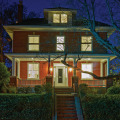But, in general, building timber-framed houses costs more than typical “stick-built” ones. This high price is due to the nature of timber frame structures. Traditional wooden frames (with mortise and tenon joinery) are always more expensive than stick construction. In addition, it creates point loads in the base of wooden posts that would be nearly impossible to properly carry to the foundation of an existing stick-framed house.
Timber frame houses are almost always custom-designed homes. SIPs are more expensive than walls with mullion frames. A wooden frame requires less wood than a conventional frame, but the parts will be much larger and will cost more. There are many options for wood species to choose from when framing wood.
Some of the most common wood species used are Douglas fir, hemlock, oak, pine and cedar. Timber frame homes generally cost more to build than a 2×4" stick-built house. The reasons for this include the cost of a high-quality wooden frame (compared to inexpensive wooden studs), superior insulation, water leak prevention, which is where a waterproofing company comes into play, and the typical use of large areas of glass. However, there are ways to keep the cost of a timber frame home low while maintaining the feel of a pole and beam.
Before you begin the design process, you should know your budget and consider it as you navigate the course of the creation process. There will be give-and-take; it's a normal part of the construction process. The budget will be one of the first questions you are asked and one of the topics that you will reconsider during your creation experience. In terms of materials used, the cost of wood is lower, but not much.
In addition, whether wood or brick is used, the rest of the construction costs will be the same. Foundations, pipes, sewers, access roads, and the like will cost the same regardless of the frame. The main savings with wooden frames is in the construction itself. The simple kit-building methods involved mean fewer specialized personnel will need to be employed.
All staff employed will complete the work in a much shorter time, which will save on labor costs. The National Housing Construction Council estimates that the use of wooden frames saves up to three months in construction time. As NHBC warranties cover 80% of British new construction, this is worth noting. Whatever the size or complexity of the design, a timber-framed house will cost 20% more on average than a similar house built with sticks.
Building a timber frame house is a real challenge, even for those with experience in other types of home construction. With Timber Framing, large frame parts are manufactured in advance in a workshop and then brought to the construction site in pieces and then joined together. A hybrid design uses a true pole and beam frame for the main living areas (large living room, kitchen, dining room), while partial or no wood structure is used in the rest of the structure (or vice versa, as desired by the customer). I was an apprentice in a timber structure company several years ago, with the aim of cutting and erecting my own structure.
In Dinkelsbuhl, Germany, I slept in a wooden frame house dating back to the 16th century (it had been converted into a small hotel). A timber-framed barn may use less structural wood than a stick-framed barn, but a timber-framed house requires non-structural, stick-framed infill walls or petrochemical and wood SIPS panels, which are costly, resource-inefficient, and have a high ecological footprint. Due to the widespread use of wooden frames by the construction industry, lenders are much less likely to make this distinction. The assembly of a prefabricated wooden structure is a much faster process than the framing process on site for a house built with sticks.
A 2,500-square-foot, 2-story home will have 6,000 BF of wood in its load-bearing frame (including exterior walls, second floor, second roof, and center load-bearing walls, but excluding first floor if not slab). For the construction of wooden structures, you can waste a lot of trees (wood) if you are not careful in your design and engineering. Most lenders prefer brick-lined timber-framed houses, since the outer surface is less susceptible to damage. A timber-framed house is a perfect solution to the problem of U.S. housing inventory and to the growing need for environmentally responsible construction. In the more traditional style, each piece of wood is milled for a particular floor plan, with pieces that fit together through mortise and tenon joinery (with a wooden peg in one wood that fits snugly into a pre-cut joint in the other). It's worth mentioning that you'll get a lot more framing material from sticks from a given tree than from heavy woods. .
.



